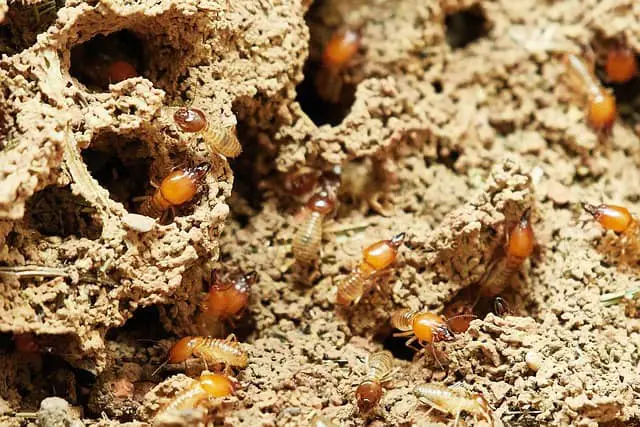Wood is a versatile and widely used material in construction, furniture making, and various other applications. However, wood is also susceptible to pests and infestations that can damage its structural integrity and aesthetics.
In this blog post, we will explore effective prevention measures and treatment methods to safeguard your wooden objects from common wood pests and infestations.
Wood Structures That Are Susceptible To Pests
Here’s a table listing some common woods and wood structures that are susceptible to termites, borers, and similar pests, along with suggested preventative measures:
| Wood/Wood Structure | Susceptibility to Pests | Preventative Measures |
|---|---|---|
| Softwoods (e.g., pine) | Highly susceptible | Use pressure-treated lumber or apply borate-based treatments |
| Hardwoods (e.g., oak) | Moderately susceptible | Apply borate-based treatments or use insect-resistant species |
| Plywood | Vulnerable to borers | Seal all edges and surfaces with paint or varnish |
| Particleboard/MDF | Highly susceptible to borers | Avoid direct contact with soil and moisture |
| Wood siding | Attracts termites and borers | Regularly inspect for signs of infestation and treat if needed |
| Wooden furniture | Prone to infestation | Apply wood preservatives and keep away from soil and moisture |
| Wood flooring | Vulnerable to termites | Use termite-resistant materials or apply chemical treatments |
| Wood fences | Attracts termites | Use pressure-treated lumber or apply termite repellents |
These are general guidelines, and it’s important to note that specific factors such as geographic location and local pest populations can influence susceptibility. Consulting with local pest control professionals can provide tailored advice based on your specific situation.
Additionally, regular inspections and timely maintenance are essential for early detection and prevention of pest infestations.
Understanding Common Wood Pests
- Termites: Termites are one of the most destructive wood pests. They feed on cellulose, causing extensive damage to wooden structures and furniture.
- Wood Borers: Wood-boring insects, such as beetles and weevils, lay their eggs in wood, and the larvae tunnel through the material, leaving behind tunnels and galleries.
- Carpenter Ants: These ants excavate wood to create their nests, potentially compromising the strength of wooden structures.
- Powderpost Beetles: Powderpost beetles lay eggs in wood, and their larvae consume the wood, leaving behind tiny exit holes and frass (sawdust).
Prevention Measures
- Moisture Control: Properly ventilate areas prone to moisture buildup as it attracts pests. Fix any leaks or sources of water intrusion promptly.
- Regular Inspections: Routinely inspect wooden structures, furniture, and items for signs of pests, including small holes, sawdust-like frass, or insect presence.
- Sealing Cracks and Openings: Seal any gaps, cracks, or openings in wooden structures to prevent easy access for pests.
- Use Treated Wood: Consider using pressure-treated or naturally resistant wood species to deter pests.
- Elevate Wooden Structures: Raise wooden structures off the ground to reduce contact with soil, minimizing the risk of termite infestation.
Treatment Methods
- Professional Extermination: In severe cases of infestation, it is advisable to seek professional pest control services to effectively eliminate pests and prevent further damage.
- Chemical Treatments: Wood preservatives or insecticides can be applied to infested wood or used preventively to protect against future infestations. Follow instructions carefully and consider consulting professionals for safe and effective application.
- Freezing or Heating: For smaller wooden objects, freezing them below -20°C (-4°F) or heating them above 50°C (122°F) can kill pests and their larvae.
- Isolation and Removal: Quarantine infested wooden items to prevent the spread of pests. Remove and replace severely damaged wood if necessary.
Final Thoughts
Preventing and treating common wood pests and infestations is crucial to safeguard the beauty and structural integrity of wooden objects. By implementing preventive measures, regularly inspecting for signs of pests, and taking prompt action, you can minimize the risk of infestation and preserve the longevity of your cherished wooden items.
Here are some bullet point tips for preventing and treating common wood pests and infestations:
• Inspect wood thoroughly before bringing it inside. Look for signs of insect damage, exit holes, small piles of wood dust, or living insects.
• Seal and paint exposed wood surfaces. This forms a physical barrier that many insects cannot penetrate. Reapply paint every few years.
• Apply borate-based wood treatment products. Borates are toxic to wood-boring insects but safe for humans. They are absorbed into the wood fibers.
• Use insecticidal dust. Products containing diatomaceous earth or silica gel can be dusted into exit holes, crawl spaces and crevices to dehydrate and kill insects.
• Apply pesticide spray. Insecticides labeled for wood-boring insects can be sprayed directly onto exposed wood. Repeat applications may be needed.
• Treat existing infestations. For powderpost beetles, apply borate dust into exit holes. For termite infestations, a professional extermination may be needed.
• Remove heavily infested wood. As a last resort, replace wood that is riddled with insect damage because treatment may not be effective.
• Remove wood debris. Clean up areas underneath decks and around the foundation to remove wood scraps where insects can breed.
• Seal potential entry points. Caulk cracks and crevices around windows, doors and utility penetrations to prevent insect entry into the home.
• Consider preventative insecticide treatments. For termites, a liquid treatment applied to the soil around the foundation can create a chemical barrier.
With a combination of inspection, sealing, wood treatments and pesticide applications when needed, you can greatly reduce your risks of wood-boring insect infestations. Regular maintenance is important to detect and address problems in the early stages before major damage occurs.
In severe cases, it is recommended to seek professional assistance to effectively eliminate pests and protect your valuable wood investments.


